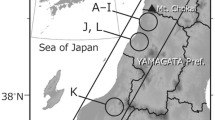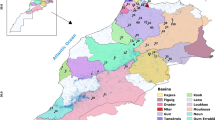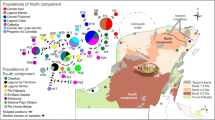Abstract
The neotropical cichlid genus Gymnogeophagus is distributed in the Río de la Plata basin and in Dos Patos and Merín coastal lagoons on the border between Uruguay and southern Brazil. A phylogeographic approach based on mitochondrial cytochrome b analysis was performed to assess the patterns and processes of differentiation in this taxon. Gymnogeophagus gymnogenys showed high haplotype diversity (H = 0.992) and corrected mtDNA genetic distances ranged from 0 to 5.3%. Our analyses yielded robust support for the existence of four monophyletic groups within G. gymnogenys from the analyzed basins. No correlation between the aforementioned clades and geographic structure was found, since individuals belonging to different phylogenetic clades inhabit the same locality. The phylogeographic approach presented here showed that these four phylogroups (1, 2, 3 and 4) were sister groups. Our present findings would corroborate that G. gymnogenys could be integrated by different phylogenetic lineages, showing an explosive differentiation pattern and confirming the hypothesis that this taxon constitutes a species complex.





Similar content being viewed by others
References
Arratia G, Cione A (1996) The record of fossil fishes of Southern South America. Muenchner Geowiss. Abh., pp 9–11
Barluenga M, Meyer A (2004) The Midas cichlid species complex: incipient sympatric speciation in Nicaraguan cichlid fishes? Mol Ecol 13:2061–2076
Barluenga M, Stölting KN, Salzburger W, Muschick M, Meyer A (2006) Sympatric speciation in Nicaraguan crater lake cichlid fish. Nature 439:719–723
Brown WM, George M Jr, Wilson AC (1979) Rapid evolution of animal mitochondrial DNA. Proc Natl Acad Sci USA 76:1967–1971
Cantatore P, Roberti M, Pesole G, Ludovico A, Milella F, Gasaleta MN, Saccone C (1994) Evolutionary analysis of cytochrome b sequences in some Perciformes: evidence for a slower rate of evolution than in mammals. J Mol Evol 39:589–597
Casciotta J, Arratia G (1993) Tertiary cichlid fishes from Argentina and reassessment of the phylogeny of New World cichlids. Kaupia 2:195–240
Chenoweth SF, Hughes JM, Keenan CP, Lavery S (1998) Concordance between dispersal and mitochondrial gene flow: isolation by distance in a tropical teleost, Lates calcarifer (Australian barramundi). Heredity 80:187–197
Durand JD, Tine M, Panfili J, Thiaw OT, Laë R (2005) Impact of glaciations and geographic distance on the genetic structure of a tropical estuarine fish, Ethmalosa fimbriata (Clupeidae, S. Bowdich, 1825). Mol Phylogenet Evol 36:277–287
Excoffier L, Smouse PE, Quattro JM (1992) Analysis of molecular variance inferred from metric distances among DNA haplotypes: application to human mitochondrial DNA restriction data. Genetics 131:479–491
Excoffier L, Laval G, Schneider S (2005) Arlequin ver. 3.0: an integrated software package for population genetics data analysis. Evolutionary Bioinformatics Online 1:47–50
Farias IP, Ortí G, Sampaio I, Schneider H, Meyer A (1999) Mitochondrial DNA phylogeny of the family Cichlidae: monophyly and fast molecular evolution of the Neotropical assemblage. J Mol Evol 48:703–711
Farias IP, Ortí G, Meyer A (2000) Total evidence: molecules, morphology, and the phylogenetics of cichlid fishes. J Exp Zool 288:76–92
Farias IP, Ortí G, Sampaio I, Schneider H, Meyer A (2001) The cytochrome b gene as a phylogenetic marker: the limits of resolution for analyzing relationships among cichlid fishes. J Mol Evol 53:89–103
Fauvelot C, Bernardi G, Planes S (2003) Reductions in the mitochondrial DNA diversity of coral reef fish provide evidence of population bottlenecks resulting from Holocene sea-level change. Evolution 57:1571–1583
Felsenstein J (1985) Confidence limits on phylogenies: an approach using the bootstrap. Evolution 39:783–791
Fu Y-X (1997) Statistical test of neutrality of mutations against population growth, hitchhiking and background selection. Genetics 147:915–925
Hensel RF (1870) Beiträge zur Kenntniss der wirbelthiere Südbrasiliensis. (Fortsetzung) Archiv für Naturgeschidite 36:50–91
Hewitt G (2000) The genetic legacy of the Quaternary ice ages. Nature 405:907–913
Hillis DM, Mable BK, Moritz C (1996) Applications of molecular systematics. In: Hillis DM, Moritz C, Mable BK (eds) Molecular systematics. 2nd edn. Sinauer Associates, Sunderland, MA, pp 515–543
Hulsey CD, García de León FJ, Johnson YS, Hendrickson DA, Near TJ (2004) Temporal diversification of Mesoamerican cichlid fishes across a major biogeographic boundary. Mol Phylogenet Evol 31:754–764
Kimura M (1980) A simple method for estimating evolutionary rates of base substitutions through comparative studies of nucleotide sequences. J Mol Evol 16:111–120
Kimura M (1981) Estimation of evolutionary distances between homologous nucleotide sequences. Proc Natl Acad Sci USA 78:454–458
Kimura M, Crow JF (1964) The number of alleles that can be maintained in a finite population. Genetics 49:725–738
Kocher TD, Thomas WK, Meyer A, Edwards SV, Pääbo S, Villablanca FX, Wilson AC (1989) Dynamics of mitochondrial DNA evolution in animals: amplification and sequencing with conserved primers. Proc Natl Acad Sci USA 86:6196–6200
Kornfield IL, Smith DC, Gagnon PS, Taylor JN (1982) The cichlid fish of Cuatro Cienagas, Mexico: direct evidence of conspecificity among distinct trophic morphs. Evolution 36:658–664
Kullander SO (2003) Family cichlidae. In: Kullander SO, Reis R, Ferraris CJ (eds) Check list of the freshwater fishes of South and Central America. Museu de Ciências e Tecnologia, Pontificia Universidade Católica do Rio Grande do Sul. Porto Alegre, pp 605–654
Kumar S, Tamura K, Nei M (2004) MEGA3: integrated software for molecular evolutionary genetics analysis and sequence alignment. Brief Bioinform 5:150–163
López-Fernández H, Taphorn DC (2004) Geophagus abalios, G. dicrozoster and G. winemilleri (Perciformes: Cichlidae), three new species from Venezuela. Zootaxa 439:1–27
López-Fernández H, Honeycutt RL, Winemiller KO (2005) Molecular phylogeny and evidence for an adaptive radiation of geophagine cichlids from South America (Perciformes: Labroidei). Mol Phylogenet Evol 34:227–244
Malabarba LR, Isaia EA (1992) The freshwater fish fauna of the Rio Tramandaí drainage, Rio Grande do Sul, with a discussion of its local origin. Comun Mus Ciênc PUCRS Sér Zool 5:197–223
Mantel N (1967) The detection of disease clustering and a generalized regression approach. Cancer Res 27:209–220
Martin AP, Bermingham E (1998) Systematics and evolution of lower Central American cichlids inferred from analysis of cytochrome b gene sequences. Mol Phylogenet Evol 9:192–203
Medrano JF, Aasen E, Sharrow L (1990) DNA extraction from nucleated red blood cells. Biotechniques 8:43
Meyer A, Kocher TD, Basasibwaki P, Wilson A (1990) Monophyletic origin of Lake Victoria fishes suggested by mitochondrial DNA sequences. Nature 347:550–553
Moritz C (1994) Applications of mitochondrial DNA analysis in conservation: a critical review. Mol Ecol 3:401–411
Nei M (1987) Molecular evolutionary genetics. Columbia University Press, New York, NY, USA
Palumbi S, Martin A, Romano S, McMillan WO, Stice L Grabowski G (1991) The simple fool’s guide to PCR. Department of Zoology and Kewalo Marine Laboratory, Univ. Hawaii, Honolulu
Panhuis TM, Butlin R, Zuk M, Tregenza T (2001) Sexual selection and speciation. Trends Ecol Evol 16:364–371
Posada D, Crandall KA (1998) Modeltest: testing the model of DNA substitution. Bioinformatics 14(9):817–818
Reis RE, Malabarba LR (1988) Revision of the neotropical cichlid genus Gymnogeophagus (Ribeiro, 1918), with descriptions of two new species (Pisces, Perciformes). Revista Bra Zool 4:259–305
Ribeiro AM (1918) Dos gêneros e três espécies novas de peixes Brasileiros determinados nas coleçoes do Museu Paulista. Revta Mus Paulista, Sao Paulo 10:787–791
Rice WR (1989) Analyzing tables of statistical tests. Evolution 43:223–225
Roe KJ, Conkel D, Liderad C (1997) Molecular systematics of Middle American cichlid fishes and the evolution of trophic-types in ‘Cichlasoma (Amphilophus)’ and ‘C. (Thorichthys)’. Mol Phylogenet Evol 7:366–376
Ronquist F, Huelsenbeck JP (2003) MrBayes 3: Bayesian phylogenetic inference under mixed models. Bioinformatics 19:1572–1574
Rozas J, Sánchez-DelBarrio JC, Messenguer X, Rozas R (2003) DnaSP, DNA polymorphism analyses by the coalescent and other methods. Bioinformatics 19:2496–2497
Rüber L, Meyer A, Sturmbauer C, Verheyen E (2001) Population structure in two sympatric species of the Lake Tanganyika cichlid tribe Eretmodini: evidence for introgression. Mol Ecol 10:1207–1225
Salzburger W, Mack T, Verheyen E, Meyer A (2005) Out of Tanganyika: genesis, explosive speciation, key-innovations and phylogeography of the haplochromine cichlid fishes. BMC Evol Biol 5:17–32
Schliewen UK, Tautz D, Pääbo S (1994) Sympatric speciation suggested by monophyly of crater lake cichlids. Nature 368:629–632
Schliewen UK, Rassmann K, Markmann M, Markert J, Kocher T, Tautz D (2001) Genetic and ecological divergence of a monophyletic cichlid species pair under fully sympatric conditions in Lake Ejagham, Cameroon. Mol Ecol 10:1471–1488
Seehausen O, Witte F, van Alphen JJM, Bouton N (1998) Direct mate choice maintains diversity in among sympatric cichlids in Lake Victoria. J Fish Biol 53:37–55
Sprechmann P (1980) Paleoecología, paleogeografía y estratigrafía de la región costera del Uruguay durante el Neógeno y Cuartario. In: Actas II Cong. Argentino Paleont., Bioestr., y I Congr. Latinoamericano Paleont., Buenos Aires. Tomo III. pp 237–256
Sturmbauer C, Verheyen E, Meyer A (1994) Mitochondrial phylogeny of the Lamprologini, the major substrate spawning lineage of cichlid fishes from Lake Tanganyika in Eastern Africa. Mol Biol Evol 11:691–703
Swofford DL (2002) PAUP* phylogenetic analysis using parsimony (* and other methods). Sinauer Associates, Inc., Sunderland, MA
Tajima F (1989) Statistical method for testing the neutral mutation hypothesis by DNA polymorphism. Genetics 123:585–595
Templeton A (2001) Using phylogeographic analyses of gene trees to test species status and processes. Mol Ecol 10:779–791
Thompson JD, Gibson TJ, Plewniak F, Jeanmougin F, Higgins DG (1997) The CLUSTAL_X windows interface: flexible strategies for multiple sequence alignment aided by quality analysis tools. Nucleic Acids Res 25:4876
Verheyen E, Salzburger W, Snoeks J, Meyer A (2003) Origin of the superflock of cichlid fishes from Lake Victoria, East Africa. Science 300:325–329
Weitzman SH, Menezes NA, Weitzman MJ (1988) Phylogenetic biogeography of the glandulocaudini (Teleostei, Characiformes, Characidae) with comments on the distributions of other freshwater fishes in eastern and southeast Brazil. Proceedings of the Workshop on Neotropical Distribution Patterns. Academia Brasileira de Ciências, pp 343–377
Wilson AB, Noack K, Meyer A (2000) Incipient speciation in sympatric Nicaraguan crater lake cichlid fishes: sexual selection vs. ecological diversification. Proc R Soc Lond Series B 267:2133–2141
Wimberger PH, Reis RE, Thornton KR (1998) Mitochondrial phylogenetics, biogeography, and evolution of parental care and mating systems in Gymnogeophagus (Perciformes: Cichlidae). In: Malabarba LR, Reis RE, Vari RP, Lucena ZM, Lucena CAS (eds) Phylogeny and classification of neotropical fishes. Editora Universitaria, Pontificia Universidad Católica do Río Grande do Sul, Porto Alegre, pp 509–518
Wright S (1951) The genetical structure of populations. Ann Eugenics 15:323–354
Acknowledgments
We wish to thank the following people: P. Laurino and Fa.Flo.Dul. organization who donated some Gymnogeophagus cf. gymnogenys and G. cf. labiatus samples; M. Loureiro and I. González who kindly provided the remaining samples and V. Gutiérrez, P. Gaiero and two anonymous reviewers for helpful suggestions for improving earlier versions of this manuscript. This research received financial support from G. García’s DT-Project (CSIC-UDELAR-Uruguay). The authors are grateful to the Japanese Government for donation of equipment.
Author information
Authors and Affiliations
Corresponding author
Appendix
Appendix
Rights and permissions
About this article
Cite this article
Pereyra, S., García, G. Patterns of genetic differentiation in the Gymnogeophagus gymnogenys species complex, a neotropical cichlid from South American basins. Environ Biol Fish 83, 245–257 (2008). https://doi.org/10.1007/s10641-008-9329-7
Received:
Accepted:
Published:
Issue Date:
DOI: https://doi.org/10.1007/s10641-008-9329-7




